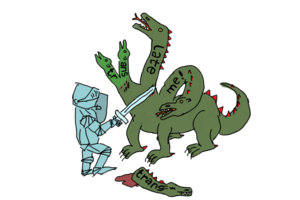Constituency Trees
 | |
| Lecture video: |
web TODO Youtube |
|---|---|
Context Free Grammar
Grammars, generally, are a way of describing a potentially infinite set of strings (sentences) using a finite set of production rules. In a context-free grammar, production rules take the following form:
V → w
V is a non-terminal symbol (for natural languages, non-terminals usually correspond to phrases, such as NP for noun phrases) and w is a (non-empty) string of terminals (words) and nonterminals. It is known that CFGs cannot fully describe natural languages but for MT, they can serve as a very useful simplification.
One nonterminal symbol serves as the top-level nonterminal where the generation starts (or where analysis ends) -- for natural languages, we usually use the symbol S (sentence).
The following example grammar can generate (or analyze) sentences such as Dogs sleep (grammatical English) or The black cat sleep (ungrammatical).
S -> NP VP NP -> dogs VP -> sleep NP -> Det Adj N Det -> the Adj -> black N -> cat
We can mend this grammar by dividing each nonterminal into two variants -- one for singular and one for plural. In general, linguistic phrases have many independent linguistic properties which would require us to split the nonterminals into an exponential number of variants.